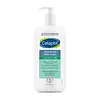What's inside
What's inside
 Key Ingredients
Key Ingredients

 Benefits
Benefits

 Concerns
Concerns

 Ingredients Side-by-side
Ingredients Side-by-side

Salicylic Acid 2%
MaskingBenzyl Alcohol
PerfumingButyrospermum Parkii Butter
Skin ConditioningCocamidopropyl Betaine
CleansingGlycerin
HumectantGlycine Soja Oil
EmollientGuar Hydroxypropyltrimonium Chloride
Skin ConditioningHydrogenated Soybean Oil
EmollientHydroxypropyl Starch Phosphate
Lactic Acid
BufferingLauric Acid
CleansingPalmitic Acid
EmollientPhenoxyethanol
PreservativeSodium Benzoate
MaskingSodium Chloride
MaskingSodium Hydroxide
BufferingSodium Lauroyl Glycinate
CleansingSodium Lauroyl Isethionate
CleansingStearic Acid
CleansingTetrasodium EDTA
Water
Skin ConditioningSalicylic Acid 2%, Benzyl Alcohol, Butyrospermum Parkii Butter, Cocamidopropyl Betaine, Glycerin, Glycine Soja Oil, Guar Hydroxypropyltrimonium Chloride, Hydrogenated Soybean Oil, Hydroxypropyl Starch Phosphate, Lactic Acid, Lauric Acid, Palmitic Acid, Phenoxyethanol, Sodium Benzoate, Sodium Chloride, Sodium Hydroxide, Sodium Lauroyl Glycinate, Sodium Lauroyl Isethionate, Stearic Acid, Tetrasodium EDTA, Water
Water
Skin ConditioningCocamidopropyl Hydroxysultaine
CleansingSodium Cocoyl Alaninate
Glycerin
HumectantCalendula Officinalis Flower Extract
MaskingHelianthus Annuus Seed Oil
EmollientAlthaea Officinalis Root Extract
Skin ConditioningCitrus Grandis Seed Extract
AstringentAsparagus Racemosus Root Extract
AntimicrobialAllium Sativum Bulb Extract
Skin ConditioningLavandula Angustifolia Flower Water
Skin ConditioningAnthemis Nobilis Flower Water
MaskingHydroxypropyl Guar Hydroxypropyltrimonium Chloride
Lactic Acid
BufferingCocamidopropyl Pg-Dimonium Chloride Phosphate
Tetrasodium Glutamate Diacetate
Glyceryl Laurate
EmollientCitric Acid
BufferingTocopherol
AntioxidantPotassium Sorbate
PreservativeSodium Benzoate
MaskingParfum
MaskingWater, Cocamidopropyl Hydroxysultaine, Sodium Cocoyl Alaninate, Glycerin, Calendula Officinalis Flower Extract, Helianthus Annuus Seed Oil, Althaea Officinalis Root Extract, Citrus Grandis Seed Extract, Asparagus Racemosus Root Extract, Allium Sativum Bulb Extract, Lavandula Angustifolia Flower Water, Anthemis Nobilis Flower Water, Hydroxypropyl Guar Hydroxypropyltrimonium Chloride, Lactic Acid, Cocamidopropyl Pg-Dimonium Chloride Phosphate, Tetrasodium Glutamate Diacetate, Glyceryl Laurate, Citric Acid, Tocopherol, Potassium Sorbate, Sodium Benzoate, Parfum
 Reviews
Reviews

Ingredients Explained
These ingredients are found in both products.
Ingredients higher up in an ingredient list are typically present in a larger amount.
Glycerin is already naturally found in your skin. It helps moisturize and protect your skin.
A study from 2016 found glycerin to be more effective as a humectant than AHAs and hyaluronic acid.
As a humectant, it helps the skin stay hydrated by pulling moisture to your skin. The low molecular weight of glycerin allows it to pull moisture into the deeper layers of your skin.
Hydrated skin improves your skin barrier; Your skin barrier helps protect against irritants and bacteria.
Glycerin has also been found to have antimicrobial and antiviral properties. Due to these properties, glycerin is often used in wound and burn treatments.
In cosmetics, glycerin is usually derived from plants such as soybean or palm. However, it can also be sourced from animals, such as tallow or animal fat.
This ingredient is organic, colorless, odorless, and non-toxic.
Glycerin is the name for this ingredient in American English. British English uses Glycerol/Glycerine.
Learn more about GlycerinLactic Acid is another well-loved alpha hydroxy acid (AHA). It is gentler than glycolic acid but still highly effective.
Its main role is to exfoliate the surface of the skin by loosening the “glue” that holds dead skin cells together. Shedding those old cells leads to smoother, softer, and more even-toned skin.
Because lactic acid molecules are larger than glycolic acid, they don’t penetrate as deeply. This means they’re less likely to sting or irritate, making it a great choice for beginners or those with sensitive skin.
Like glycolic acid, it can:
Lactic acid also acts as a humectant (like hyaluronic acid). It can draw water into the skin to improve hydration and also plays a role in the skin's natural moisturizing factor (NMF) in the form of sodium lactate.
Studies show it can boost ceramide production to strengthen the skin barrier and even help balance the skin’s microbiome.
To get results, choose products with a pH between 3-4.
Lower strengths (5-12%) focus on surface exfoliation; higher strengths (12% and up) can reach deeper in the dermis (deeper, supportive layer) to improve skin texture and firmness over time.
Though it was originally derived from milk, most modern lactic acid used in skincare is vegan. It is made through non-dairy fermentation to create a bio-identical and stable form suitable for all formulations.
When lactic acid shows up near the end of an ingredient list, it usually means the brand added just a tiny amount to adjust the product’s pH.
Legend has it that Cleopatra used to bathe in sour milk to help reduce wrinkles.
Lactic acid is truly a gentle multitasker: it exfoliates, hydrates, strengthens, and brightens. It's a great ingredient for giving your skin a smooth, glowing, and healthy look without the harshness of stronger acids.
Read more about some other popular AHA's here:
Learn more about Lactic AcidSodium Benzoate is a preservative. It's used in both cosmetic and food products to inhibit the growth of mold and bacteria. It is typically produced synthetically.
Both the US FDA and EU Health Committee have approved the use of sodium benzoate. In the US, levels of 0.1% (of the total product) are allowed.
Sodium benzoate works as a preservative by inhibiting the growth of bacteria inside of cells. It prevents the cell from fermenting a type of sugar using an enzyme called phosphofructokinase.
It is the salt of benzoic acid. Foods containing sodium benzoate include soda, salad dressings, condiments, fruit juices, wines, and snack foods.
Studies for using ascorbic acid and sodium benzoate in cosmetics are lacking, especially in skincare routines with multiple steps.
We always recommend speaking with a professional, such as a dermatologist, if you have any concerns.
Learn more about Sodium BenzoateWater. It's the most common cosmetic ingredient of all. You'll usually see it at the top of ingredient lists, meaning that it makes up the largest part of the product.
So why is it so popular? Water most often acts as a solvent - this means that it helps dissolve other ingredients into the formulation.
You'll also recognize water as that liquid we all need to stay alive. If you see this, drink a glass of water. Stay hydrated!
Learn more about Water